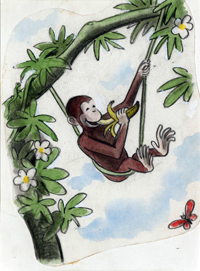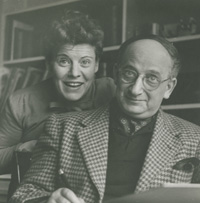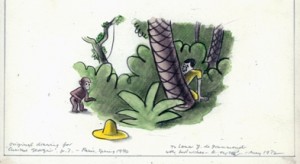
H. A. Rey, final illustration for "This is George. He lived in Africa," published in The Original Curious George (1998), France, 1939–40, watercolor, charcoal, and color pencil on paper. H. A. & Margret Rey Papers, de Grummond Children's Literature Collection, McCain Library and Archives, The University of Southern Mississippi.
(STOCKBRIDGE, Mass.) – Curious George Saves the Day: The Art of Margret and H.A. Rey, a traveling exhibition created by the Jewish Museum in New York City on display at the Norman Rockwell Museum from November 12, 2011 through February 5, 2012, reveals the little-known story of how the popular children’s book character was both born of and influenced by his creators’ escape from the Nazi occupation of Paris. Opening events on Saturday, November 12, include a public opening from 1 to 4 p..m., and a curator’s talk and reception at 6:30 p.m. The events will also mark the opening of the exhibit Pop-Up! The Magical World of Movable Books.
Interpreting the role that Curious George played in safeguarding his own creators in times of danger as symbolic, Claudia Nahson, curator at The Jewish Museum who organized Curious George Saves the Day: The Art of Margret and H. A. Rey, delves into the remarkable lives and works of Margret and H. A. Rey, who in 1940 fled Paris with a Curious George manuscript in their suitcase. Art and documentation related to their escape from Nazi-occupied Europe, and the parallels between the obstacles the couple faced and the drawings that may have saved their lives will be explored in the exhibit.
The impish monkey protagonist of many adventures, Curious George may never have seen the light of day were it not for the determination and courage of his creators: illustrator H.A. Rey (1898 – 1977) and his wife, author and artist Margret Rey (1906 – 1996). They were both born in Hamburg, Germany, to Jewish families and lived together in Paris from 1936 to 1940. Hours before the Nazis marched into the city in June 1940, the Reys fled on bicycles carrying drawings for their children’s stories including one about a mischievous monkey, then named Fifi. Not only did they save their animal characters, but the Reys themselves were saved by their illustrations when authorities found them in their belongings. This may explain why saving the day after a narrow escape became the premise of most of their Curious George stories.
After their fateful escape from Paris and a four-month journey across France, Spain, Portugal, and Brazil, the couple settled in New York in the fall of 1940. In all, the Reys authored and illustrated over thirty books, most of them for children, with seven of them starring Curious George. Seventy years after the arrival of Curious George in America, the monkey’s antics have been translated into over a dozen languages including Hebrew and Yiddish, to the delight of readers, young and old, around the world.

Margret and H. A. Rey, United States, late 1940s. H. A. & Margret Rey Papers, de Grummond Children's Literature Collection, McCain Library and Archives, The University of Southern Mississippi.
Organized by The Jewish Museum in New York, this new exhibition will offer visitors a rare opportunity to view nearly 80 original drawings and vibrant watercolors of Curious George and other characters. Many of these works have never been on display before. Preparatory dummy books, vintage photographs, and documentation related to the Reys’ escape from Nazi Europe, such as H.A. Rey’s journals detailing the couple’s perilous journey to freedom, are also included. One of the exhibition galleries will be transformed into a reading room for visitors of all ages inspired by the beloved monkey’s escapades in “Curious George Flies a Kite.”
In addition, the exhibition features an interactive timeline, accessed via a touch-screen computer, about the Reys’ life in France from the late 1930s through their fateful escape in the summer of 1940. Visitors will be able to view additional pages of H.A. Rey’s journal detailing the couple’s journey to safety, images of illustrations by H.A. Rey and photographs taken by Margret Rey in France, documentary photography related to early World War II in France, and historic video, as well as listen to an interview with the couple.
Art and documentation in the exhibition has been lent by the de Grummond Children’s Literature Collection, McCain Library and Archives, The University of Southern Mississippi.
H.A. Rey (né Hans Augusto Reyersbach) had no formal art training, but in the early 1920s he designed and lithographed circus posters in Hamburg. Margret Rey (née Margarete Waldstein) studied art and photography at the Bauhaus School and then worked in advertising firms and photographic studios in Germany and England in the late 1920s and early 1930s. The two first met in Hamburg before Hans departed for Rio de Janeiro in 1925, to work for a relative. They were married in 1935, after Margret joined him there, following Hitler’s ascent to power in Germany.
An extended honeymoon took them to Paris, where the Reys stayed on and began working on children’s books. Filled with gentle humor and illustrated with H.A. Rey’s vivid watercolors, their stories were usually formulated by Hans and later developed by Margret into a full plot.

H. A. Rey, final illustration for "One day George saw a man. He had on a large yellow straw hat," published in The Original Curious George (1998), France, 1939–40, watercolor, charcoal, and color pencil on paper. H. A. & Margret Rey Papers, de Grummond Children's Literature Collection, McCain Library and Archives, The University of Southern Mississippi.
Following the Nazi invasion of Poland in September 1939 and France’s declaration of war against Germany, the Reys sought refuge first in the southern region of Gers and later in Normandy, fleeing Paris for the third and last time on June 12, 1940. Despite the difficulties, the Reys were prolific in France, publishing seven books from 1937 through 1939 (three in both French and English) and completing the manuscripts and drawings for at least four others later published in America. On October 14, 1940, the Reys finally reached New York. Within a month the publisher Houghton Mifflin accepted four of the manuscripts they had brought with them for publication.
Exhibition highlights include original drawings and bright watercolors for Raffy and the 9 Monkeys (in which Curious George makes his debut as Fifi), featuring a lonely giraffe named Raffy and the nine monkeys that become his playmates; Whiteblack the Penguin Sees the World with Whiteblack setting out on a globe-trotting pursuit of new adventures; Fifi: The Adventures of a Monkey (later published as Curious George); and subsequent American escapades of the famous monkey hero.
Whether falsely alarming the fire department while experimenting with a telephone, going up in the air with a bunch of balloons or a kite, or falling into the water after a failed attempt to fish with a mop, the little monkey is always in trouble, both propelled and undone by his insatiable curiosity and appetite for adventure.
While the idea of the monkey’s narrow escape from danger was introduced in the first Curious George story created by the Reys in France, the concept of “saving the day” is only used in their later books written in the safety of America. By the time the man with the yellow hat comes to his rescue, George’s capers have already been mitigated with some poetic justice, which may be understood as emblematic of the important role the character had played both in saving the Reys’ lives when fleeing Nazi Europe and later helping them rebuild their careers in the United States.
In turn, the little monkey born in France acts out the fantasies of many immigrants: he lands an acting job in Hollywood soon upon arrival, advances research by traveling in a spaceship, and makes it to the front page of newspapers, all the while getting thoroughly Americanized.
EXHIBITION OPENING EVENT
“Curious George Saves the Day: The Art of Margret and H. A. Rey” and “Pop-Up! The Magical World of Movable Books”
Saturday, November 12, 1 to 4 p.m.
Explore the art of Curious George, the beloved, irrepressible monkey of children’s booklore, who is famous for his ability to “save the day.” Interpreting the role he played in safeguarding his own creators in times of danger, this special exhibition delves into the remarkable lives and works of Margret and H. A. Rey. In addition, we’ll explore the history and wonder of pop-up books in a lively installation of Barbara and Bernard Shapiro’s extensive collection of movable literature for the young and the young at heart– from whimsy and fantasy to science and suspense. Free with Museum admission, members free.
EXHIBITION OPENING PROGRAM
“Curious George Saves the Day: The Art of Margret and H.A. Rey” and
“Pop-Up! The Magical World of Movable Books”
Saturday, November 12, 6:30 p.m.
Interpreting the role that Curious George played in safeguarding his own creators in times of danger as symbolic, Claudia Nahson, Curator at The Jewish Museum, delves into the remarkable lives and works of Margret and H. A. Rey, who in 1940 fled Paris with a Curious George manuscript in their suitcase. Art and documentation related to their escape from Nazi-occupied Europe, and the parallels between the obstacles the couple faced and the drawings that may have saved their lives will be explored. Claudia Nahson is the curator of “Curious George Saves the Day: The Art of Margret and H. A. Rey.” A festive reception will follow. $15, members free.
DECEMBER SCHOOL VACATION WEEK WORKSHOPS
Just Curious! Drop-in Art for the Whole Family
Monday through Saturday
December 26 through 31, 1 to 5 p.m.
Step into the world of children’s books during these inspiring art workshops that explore the Museum’s family-friendly “Curious George” and “Pop-Up” exhibitions. Take one or take them all! Free with Museum admission, members free.
SPECIAL NEW YEAR’S OFFER
Yellow Hat Week!
Monday through Friday, January 2 through 6
Ring in the New Year and bond with Curious George’s Yellow Hat Man by wearing a store-bought or homemade yellow hat to the Museum, and receive $2 off admissions!
AFTERNOON FOR EDUCATORS AND LIBRARIANS
The Journey that Saved Curious George
Friday, January 13, 3:30 to 5:30 p.m.
Trace the personal and artistic journey of Curious George creators Margret and H. A. Rey with author Louise Borden, who documented their 1940 wartime escape from Paris with few possessions but their children’s book manuscripts, which helped to ensure their safety. In her book, “The Journey that Saved Curious George,” the author used primary resources, including Hans Rey’s pocket diaries, to tell this dramatic tale. Exhibition tours, classroom materials, and refreshments will be included. Remarks at 4p.m. Free.
THE PRIVATE LIVES OF ARTISTS
“Curious George Saves the Day! The Story of Margret and H. A. Rey”
Saturday, January 14, 2012 1 p.m.
Discover the unexpected during this dynamic look at the remarkable lives of Margret and H.A. Rey, creators of Curious George and his unforgettable friends, with historian/author Louise Borden. In 1940, the couple fled Paris with a Curious George manuscript in their suitcase. During a tense inspection of their belongings by border officials, the illustrations were found and they were allowed to continue on their way. Free with Museum admission.
ART WORKSHOP
Watercolor Whimsy
Saturday, January 28, 10 a.m. to 3 p.m.
Paint whimsical watercolors inspired by the art, props, and costumes portrayed in our special exhibition, “Curious George Saves the Day,” with accomplished artist Deborah Hanson Greene. Unique hats, costumes, stuffed treasures, and memorabilia will provide a rich sampling of colors and textures. The artist’s work has been exhibited regionally and beyond. $20, $15 members.
Norman Rockwell Museum is the preeminent museum of American illustration art. Dedicated to art education and art appreciation inspired by the enduring legacy of Norman Rockwell, the Museum stewards the world’s largest and most significant collection of Rockwell art, and presents the works of contemporary and past masters of illustration. The Museum’s holdings include Rockwell’s last studio, moved from its original location to the Museum grounds, and the Norman Rockwell Archives, a 200,000-object collection undergoing digital preservation through ProjectNORMAN, “A Save America’s Treasures Project.” The Museum is also home to the new Rockwell Center for American Visual Studies, the nation’s first research institute devoted to the art of illustration. In 2008, Norman Rockwell Museum became the first-ever museum recipient of the National Humanities Medal, America’s highest honor in the field.
Norman Rockwell Museum is located on 36 park-like acres in Stockbridge, Massachusetts, Rockwell’s hometown for the last 25 years of his life. The Museum is open year-round. From May through October, hours are 10 a.m. to 5 p.m. daily; from November through April, hours are 10 a.m. to 4 p.m. Monday through Friday, and 10 a.m. to 5 p.m. on weekends and holidays. Rockwell’s studio is open May through October, 10 a.m. to 5 p.m. Museum admission is $15, $13.50 for seniors, $10 for students, $5 for kids and teens 6 to 18, and free for children 5 and under..
